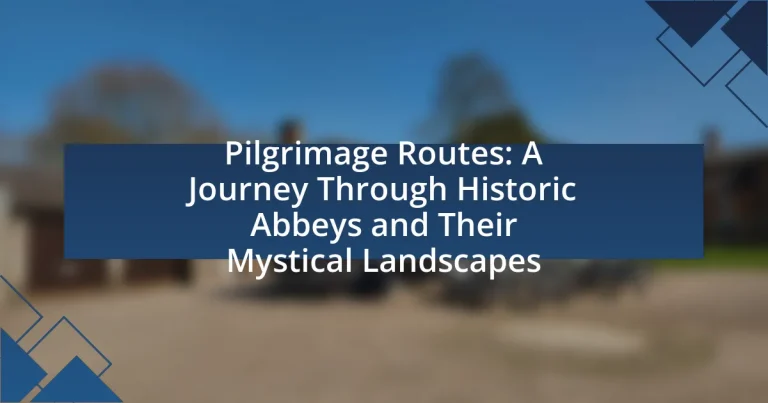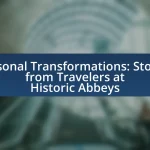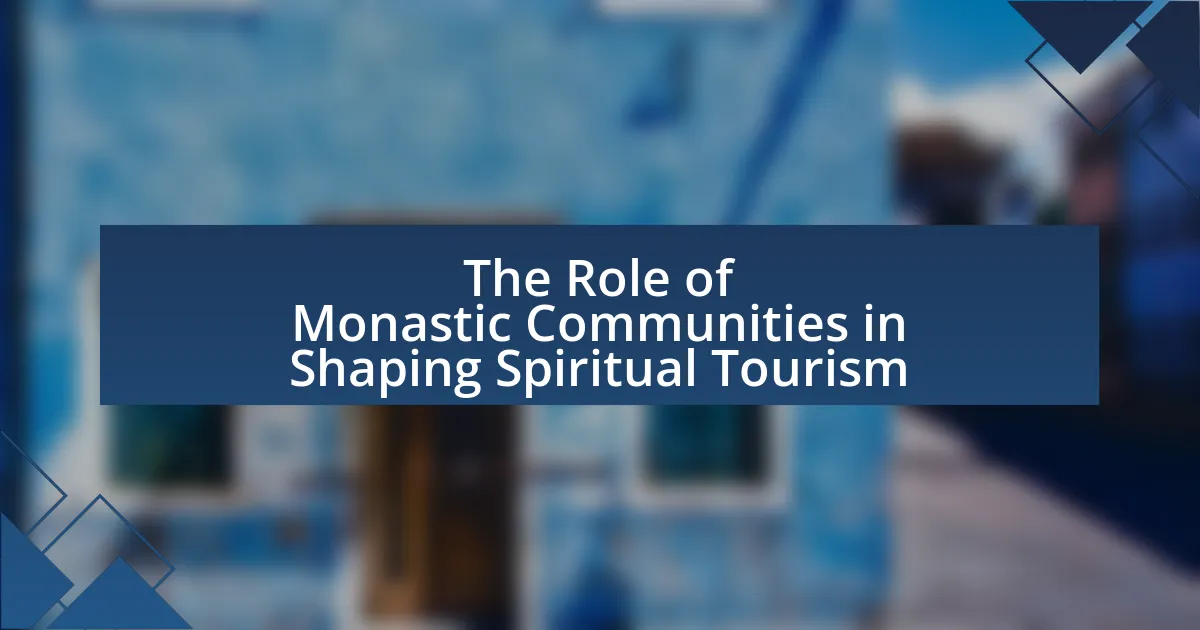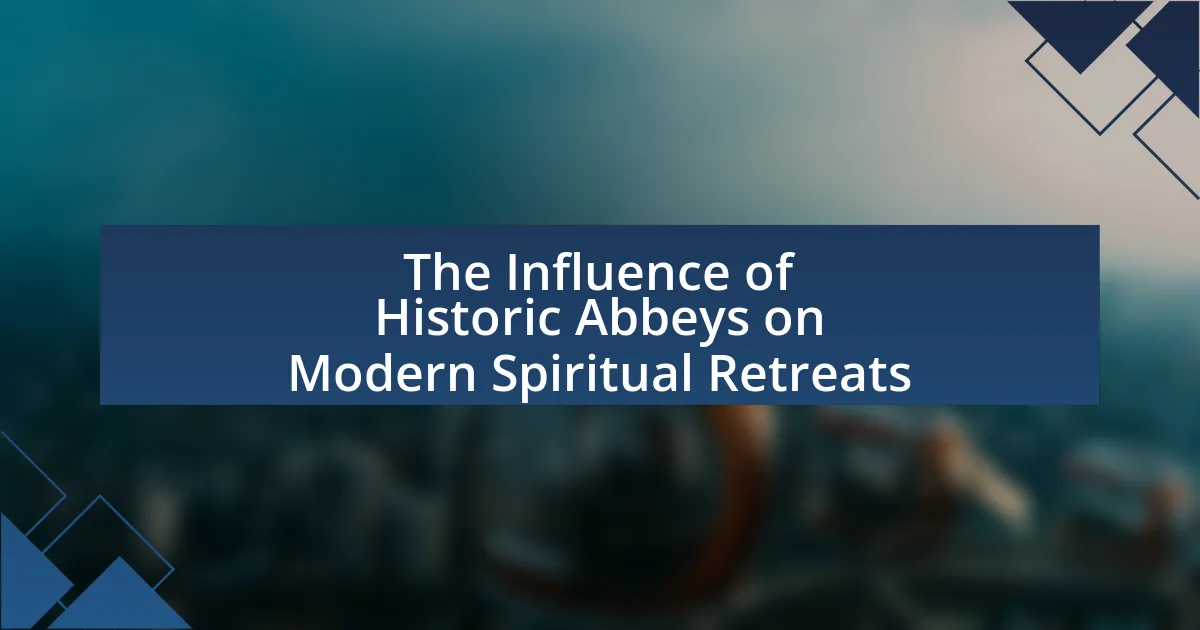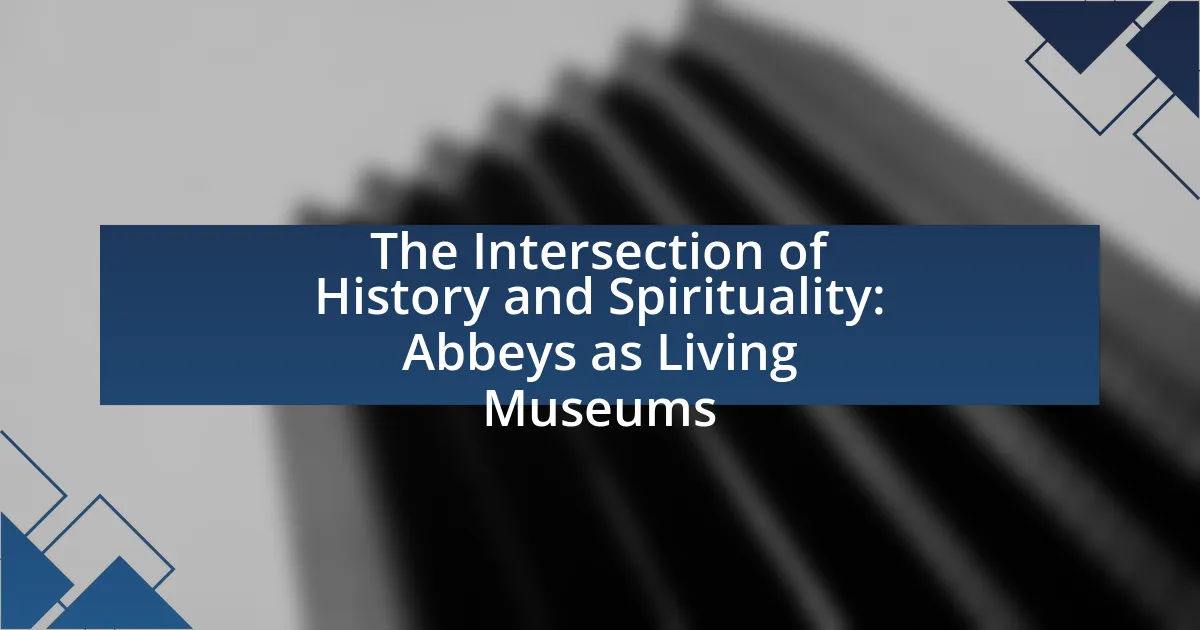Pilgrimage routes are designated paths leading to sacred sites, playing a significant role in spiritual reflection, community bonding, and cultural exchange. This article explores the historical and contemporary significance of these routes, particularly their connections to historic abbeys and the mystical landscapes they traverse. Key pilgrimage routes such as the Camino de Santiago, the Hajj, and the Via Francigena are examined, highlighting their cultural heritage and the unique experiences they offer. Additionally, the article discusses the preparation required for a pilgrimage journey, the challenges faced by pilgrims, and the spiritual benefits derived from these transformative experiences.

What are Pilgrimage Routes and Their Significance?
Pilgrimage routes are designated paths that individuals travel to reach sacred sites, often associated with religious significance. These routes serve as a means for spiritual reflection, community bonding, and cultural exchange, as evidenced by historical practices where millions have journeyed to sites like Santiago de Compostela in Spain, which has been a pilgrimage destination since the 9th century. The significance of these routes lies in their ability to foster a sense of purpose and connection to the divine, as well as their role in preserving cultural heritage and promoting tourism in regions rich with history and spirituality.
How do Pilgrimage Routes connect to historic abbeys?
Pilgrimage routes connect to historic abbeys by serving as pathways that guide pilgrims to these significant religious sites. These routes often have historical significance, as many were established during the medieval period when abbeys were central to spiritual life and community. For example, the Camino de Santiago leads to the Cathedral of Santiago de Compostela, which houses the remains of Saint James, making it a focal point for pilgrims. Additionally, many pilgrimage routes are marked by waymarkers and signs that direct travelers to abbeys, reinforcing their role as destinations for spiritual reflection and community gathering.
What role do abbeys play in the context of pilgrimage?
Abbeys serve as significant destinations and waypoints for pilgrims, providing spiritual, communal, and logistical support during their journeys. Historically, abbeys have been centers of religious life, offering a place for worship, reflection, and hospitality to those undertaking pilgrimages. Many abbeys are located along established pilgrimage routes, such as the Camino de Santiago, where they provide shelter, food, and guidance to travelers. The presence of relics, sacred sites, and the opportunity for spiritual renewal at these abbeys enhances the pilgrimage experience, making them integral to the overall journey of faith.
How have pilgrimage routes evolved over time?
Pilgrimage routes have evolved from ancient paths used for spiritual journeys to structured networks that accommodate modern travelers. Initially, these routes were often informal, guided by local traditions and religious significance, such as the Camino de Santiago, which dates back to the 9th century and became formalized in the Middle Ages. Over time, the rise of organized religion and the establishment of pilgrimage sites led to the creation of marked trails, infrastructure like hostels, and services catering to pilgrims. In contemporary times, pilgrimage routes have adapted to include modern amenities and technology, such as mobile apps for navigation and information, reflecting a blend of tradition and modernity. This evolution illustrates the changing nature of spiritual journeys while maintaining their historical and cultural significance.
Why are mystical landscapes important in pilgrimage journeys?
Mystical landscapes are important in pilgrimage journeys because they enhance the spiritual experience and provide a sense of connection to the divine. These landscapes often feature natural elements such as mountains, rivers, and forests that evoke feelings of awe and contemplation, which are essential for reflection and personal growth during the pilgrimage. Historical evidence shows that many pilgrimage routes, like the Camino de Santiago, are designed to lead travelers through such landscapes, reinforcing the belief that nature can facilitate spiritual encounters. Additionally, studies indicate that immersion in these environments can lead to increased feelings of peace and transcendence, further validating their significance in the pilgrimage experience.
What types of landscapes are commonly associated with pilgrimage routes?
Pilgrimage routes are commonly associated with diverse landscapes, including mountainous terrains, rolling hills, coastal paths, and serene countryside. These varied landscapes enhance the spiritual experience of pilgrims, as seen in routes like the Camino de Santiago, which traverses both rugged mountains and tranquil fields. Historical records indicate that many pilgrimage paths were intentionally designed to lead through natural beauty, fostering reflection and connection with the divine. For instance, the Via Francigena in Italy showcases picturesque valleys and ancient forests, further emphasizing the significance of landscape in pilgrimage traditions.
How do these landscapes enhance the pilgrimage experience?
Landscapes enhance the pilgrimage experience by providing a profound sense of connection to nature and spirituality. The natural beauty and historical significance of these landscapes often evoke feelings of reflection and contemplation, which are essential for pilgrims seeking spiritual growth. For instance, the serene environments surrounding historic abbeys, such as rolling hills or tranquil rivers, create a peaceful atmosphere conducive to meditation and introspection. Additionally, these landscapes often hold cultural and historical narratives that enrich the pilgrimage, as seen in routes like the Camino de Santiago, where the varied terrain reflects centuries of religious devotion and community. This combination of natural beauty and historical context deepens the emotional and spiritual impact of the pilgrimage journey.
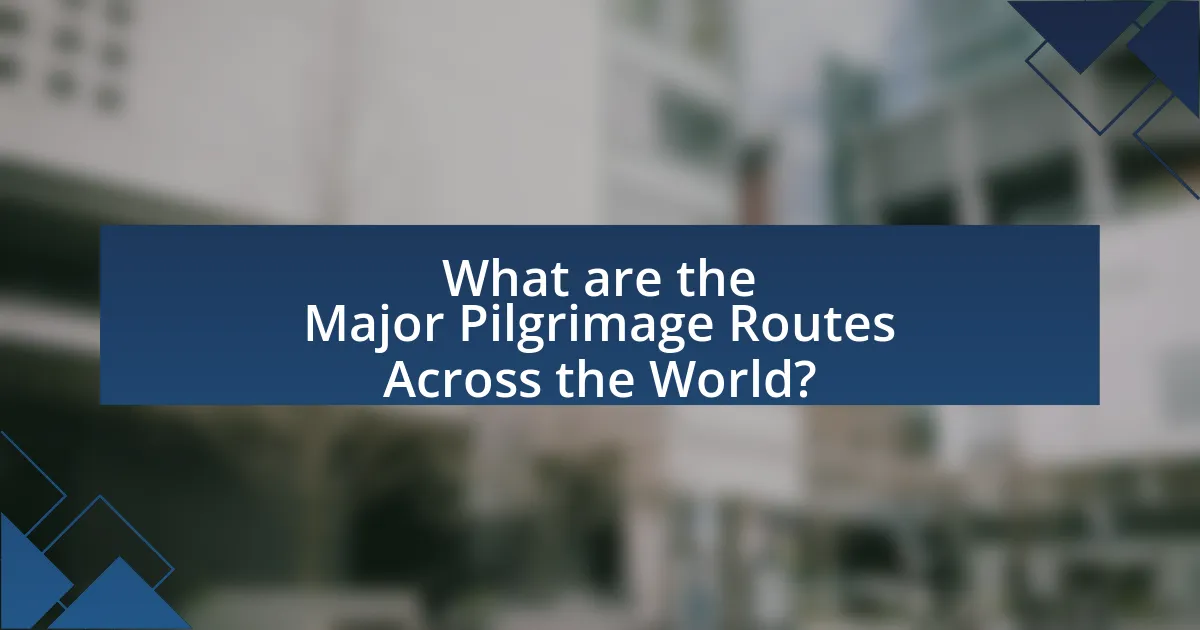
What are the Major Pilgrimage Routes Across the World?
The major pilgrimage routes across the world include the Camino de Santiago in Spain, the Hajj to Mecca in Saudi Arabia, the Kumbh Mela in India, the Via Francigena in Italy, and the Shikoku Pilgrimage in Japan. The Camino de Santiago, a network of routes leading to the shrine of Saint James, has been a significant Christian pilgrimage since the 9th century, attracting thousands annually. The Hajj, an obligatory Islamic pilgrimage, draws millions of Muslims to Mecca each year, with over 2 million participants in 2019 alone. The Kumbh Mela, a Hindu festival, occurs every 12 years at four locations in India, with attendance reaching over 120 million in 2013. The Via Francigena, a historic route from Canterbury to Rome, has been traveled by pilgrims since the Middle Ages. Lastly, the Shikoku Pilgrimage consists of 88 temples associated with the Buddhist monk Kobo Daishi, attracting both spiritual seekers and tourists.
Which pilgrimage routes are most famous for their historic abbeys?
The most famous pilgrimage routes known for their historic abbeys include the Camino de Santiago, the Via Francigena, and the Pilgrimage to Canterbury. The Camino de Santiago, particularly the French Way, features numerous abbeys such as the Abbey of Saint-Jean-Baptiste and the Monastery of San Millán de la Cogolla, which date back to the medieval period. The Via Francigena, stretching from Canterbury to Rome, is home to significant abbeys like the Abbey of Monte Cassino, founded by St. Benedict in the 6th century. The Pilgrimage to Canterbury is renowned for its connection to the Canterbury Cathedral, which houses the shrine of Thomas Becket, a pivotal figure in Christian history. These routes not only serve as spiritual journeys but also showcase architectural and historical significance through their abbeys.
What are the key features of the Camino de Santiago?
The key features of the Camino de Santiago include its historical significance, diverse routes, cultural heritage, and spiritual experience. The Camino de Santiago, also known as the Way of St. James, is a network of pilgrimage routes leading to the shrine of the apostle Saint James in Santiago de Compostela, Spain. Historically, it has been a major pilgrimage site since the 9th century, recognized by UNESCO as a World Heritage Site in 1993, which underscores its cultural importance. The routes vary in length and difficulty, with the most popular being the Camino Francés, which spans approximately 780 kilometers. Pilgrims experience a rich tapestry of landscapes, from mountains to vineyards, and encounter numerous historic abbeys and churches along the way, enhancing the spiritual journey. The Camino fosters a sense of community among travelers, promoting reflection and personal growth, which is a central aspect of the pilgrimage experience.
How does the Via Francigena connect to significant abbeys?
The Via Francigena connects to significant abbeys by serving as a historical pilgrimage route that links various religious sites across Europe, particularly in Italy. This route includes notable abbeys such as the Abbey of Saint Bernard in Aosta and the Abbey of Monte Cassino, which are strategically located along the path to Rome. The Via Francigena was established in the 9th century and has been a vital pilgrimage route for centuries, facilitating spiritual journeys and cultural exchanges among pilgrims visiting these abbeys. The presence of these abbeys along the route underscores the historical significance of the Via Francigena as a conduit for faith and community, enriching the pilgrimage experience through their architectural and spiritual heritage.
What lesser-known pilgrimage routes should be explored?
Lesser-known pilgrimage routes that should be explored include the Via Francigena, the Camino de Santiago’s lesser-known paths, and the Pilgrimage to Santiago de Compostela via the Camino Primitivo. The Via Francigena, stretching from Canterbury to Rome, offers a rich historical context, having been used by pilgrims since the 9th century. The Camino de Santiago features alternative routes like the Camino del Norte, which runs along the northern coast of Spain, providing stunning coastal views and fewer crowds. The Camino Primitivo, recognized as the original route to Santiago, showcases the beauty of rural Spain and has been a pilgrimage path since the 9th century. These routes not only offer spiritual experiences but also immerse travelers in diverse landscapes and cultural heritage.
What unique abbeys can be found along the Via de la Plata?
The unique abbeys found along the Via de la Plata include the Abbey of Santa María de Moreruela, the Abbey of San Isidro de Dueñas, and the Abbey of San Juan de la Peña. The Abbey of Santa María de Moreruela, established in the 12th century, is known for its impressive Romanesque architecture and historical significance as a Cistercian monastery. The Abbey of San Isidro de Dueñas, founded in the 11th century, features a blend of Romanesque and Gothic styles, reflecting its long history. Lastly, the Abbey of San Juan de la Peña, dating back to the 10th century, is notable for its stunning location and unique rock-hewn architecture, making it a significant pilgrimage site.
How does the St. Olav Way offer a different pilgrimage experience?
The St. Olav Way offers a different pilgrimage experience through its unique blend of historical significance and natural beauty, specifically connecting Norway to the legacy of St. Olav, the patron saint of Norway. This pilgrimage route, which spans approximately 640 kilometers, allows pilgrims to traverse diverse landscapes, including forests, mountains, and coastal areas, while visiting ancient churches and historical sites linked to Viking history. The path emphasizes spiritual reflection and community engagement, as pilgrims often share their journey with others, fostering a sense of camaraderie. Additionally, the St. Olav Way is less commercialized compared to other pilgrimage routes, providing a more authentic and immersive experience in nature and spirituality.

How to Prepare for a Pilgrimage Journey?
To prepare for a pilgrimage journey, individuals should conduct thorough research on the route, including its historical significance and physical demands. Understanding the terrain, climate, and cultural aspects of the pilgrimage enhances the experience and ensures readiness. For instance, the Camino de Santiago, a well-known pilgrimage route, requires knowledge of its various paths, which differ in difficulty and scenery. Additionally, packing appropriate gear, such as comfortable footwear and weather-appropriate clothing, is essential for physical comfort and safety during the journey. Proper preparation also includes planning accommodations and ensuring access to food and water along the route, as many pilgrimage paths traverse remote areas.
What essential items should be packed for a pilgrimage?
Essential items to pack for a pilgrimage include comfortable walking shoes, a sturdy backpack, water bottles, a first aid kit, and weather-appropriate clothing. Comfortable walking shoes are crucial as pilgrims often cover long distances on foot, while a sturdy backpack allows for easy carrying of supplies. Hydration is vital, making water bottles necessary, and a first aid kit ensures preparedness for minor injuries. Weather-appropriate clothing, including layers and rain gear, protects against changing conditions, which is important for maintaining comfort and health during the journey.
How can one choose the right footwear for long walks?
To choose the right footwear for long walks, select shoes that provide adequate support, cushioning, and fit. Proper footwear should have a firm heel counter, a cushioned midsole, and a breathable upper material to enhance comfort during extended walking. Studies indicate that shoes designed for walking can reduce the risk of blisters and foot fatigue, which are common issues on long journeys. Additionally, ensuring the shoes fit well—allowing for a thumb’s width of space at the toe—can prevent discomfort and injuries.
What clothing is best suited for varying weather conditions?
Layered clothing is best suited for varying weather conditions. This approach allows for easy adjustment to temperature changes and varying levels of activity. For example, a moisture-wicking base layer helps manage sweat, an insulating mid-layer provides warmth, and a waterproof outer layer protects against rain and wind. According to the American College of Sports Medicine, layering is essential for outdoor activities, as it enables individuals to adapt to fluctuating weather, ensuring comfort and safety during long journeys, such as those on pilgrimage routes.
What tips can enhance the pilgrimage experience?
To enhance the pilgrimage experience, travelers should engage in thorough preparation, including researching the route and understanding its historical significance. This preparation allows pilgrims to appreciate the cultural and spiritual context of the journey, as many pilgrimage routes, such as the Camino de Santiago, are steeped in history and tradition. Additionally, maintaining physical fitness is crucial, as many routes involve long walks through varied terrain, which can be physically demanding. Pilgrims should also consider traveling during off-peak seasons to avoid crowds, allowing for a more reflective and personal experience. Lastly, keeping a journal during the pilgrimage can help in processing thoughts and emotions, making the journey more meaningful.
How can mindfulness practices be integrated into the journey?
Mindfulness practices can be integrated into the pilgrimage journey by incorporating techniques such as meditation, breath awareness, and reflective journaling during the travel experience. Pilgrims can pause at significant landmarks, such as historic abbeys, to engage in short meditation sessions, allowing them to connect deeply with their surroundings and enhance their spiritual experience. Research indicates that mindfulness can improve emotional well-being and reduce stress, which is particularly beneficial during physically demanding journeys. For instance, a study published in the Journal of Happiness Studies found that mindfulness practices significantly enhance the overall experience of participants in spiritual retreats, suggesting that similar benefits can be expected on pilgrimage routes.
What are the best ways to connect with fellow pilgrims?
The best ways to connect with fellow pilgrims include participating in group activities, sharing meals, and engaging in conversations during the journey. Group activities, such as guided tours or communal prayers, foster a sense of community and allow for shared experiences. Sharing meals creates opportunities for informal discussions, where pilgrims can exchange stories and insights about their journeys. Engaging in conversations during rest stops or while walking side by side encourages personal connections and the sharing of motivations for pilgrimage. These methods are effective as they promote interaction and bonding among individuals who share a common purpose.
What are common challenges faced during pilgrimage?
Common challenges faced during pilgrimage include physical exhaustion, logistical difficulties, and emotional strain. Pilgrims often walk long distances over varied terrain, leading to fatigue and potential injuries. Additionally, logistical issues such as inadequate accommodation, food shortages, and navigation problems can arise, complicating the journey. Emotional challenges may stem from the spiritual significance of the pilgrimage, which can evoke feelings of anxiety or introspection. These challenges are documented in various studies, highlighting the demanding nature of pilgrimage experiences.
How can physical endurance be built before embarking on a pilgrimage?
To build physical endurance before embarking on a pilgrimage, individuals should engage in a structured training program that includes cardiovascular exercises, strength training, and gradual distance walking. Cardiovascular exercises, such as running, cycling, or swimming, enhance heart and lung capacity, which is essential for long-distance walking. Strength training, focusing on the legs, core, and back, helps support the body during extended periods of activity. Gradually increasing walking distances, starting with shorter hikes and progressively extending them, conditions the body to handle the demands of a pilgrimage. Research indicates that a consistent training regimen can improve endurance by up to 30% over several weeks, making it crucial for successful pilgrimage preparation.
What strategies can help manage mental fatigue during long walks?
To manage mental fatigue during long walks, individuals can employ strategies such as setting achievable goals, practicing mindfulness, and taking regular breaks. Setting achievable goals helps maintain motivation and provides a sense of accomplishment, which can counteract feelings of fatigue. Mindfulness techniques, such as focusing on breathing or the surrounding environment, can enhance mental clarity and reduce stress. Taking regular breaks allows for physical rest and mental rejuvenation, which is essential for sustaining energy levels over extended periods. Research indicates that these strategies can significantly improve overall walking experiences and mental well-being, as they promote a balanced approach to physical activity and mental engagement.
What are the spiritual benefits of undertaking a pilgrimage?
Undertaking a pilgrimage offers profound spiritual benefits, including enhanced self-reflection, a deeper connection to faith, and a sense of community. Pilgrims often experience a transformative journey that encourages introspection and personal growth, allowing them to confront their beliefs and values. This process can lead to a renewed sense of purpose and clarity in one’s spiritual life. Additionally, the act of traveling to sacred sites fosters a stronger connection to one’s faith tradition, as pilgrims engage with historical and spiritual narratives that resonate with their beliefs. Furthermore, the communal aspect of pilgrimage creates bonds among participants, fostering a shared sense of spirituality and support, which can enhance the overall experience. Historical accounts, such as those from the Camino de Santiago, illustrate how pilgrims often return with a heightened sense of spirituality and fulfillment, validating these benefits.
How does pilgrimage foster personal reflection and growth?
Pilgrimage fosters personal reflection and growth by providing individuals with a structured journey that encourages introspection and spiritual exploration. The act of traveling to sacred sites often involves physical challenges and moments of solitude, which can lead to deeper self-awareness and contemplation. Historical accounts, such as those from the Camino de Santiago, illustrate how pilgrims often report transformative experiences, gaining clarity on personal issues and a renewed sense of purpose. Additionally, the communal aspect of pilgrimage allows for shared experiences and discussions that further enhance personal insights and emotional growth.
What role does community play in the spiritual journey of pilgrims?
Community plays a crucial role in the spiritual journey of pilgrims by providing support, shared experiences, and a sense of belonging. Pilgrims often travel in groups or join established communities along pilgrimage routes, which fosters connections and enhances their spiritual experience. For instance, the Camino de Santiago attracts thousands of pilgrims who share their stories and challenges, creating a collective atmosphere that deepens individual spirituality. Research indicates that communal activities, such as group prayers and shared meals, significantly enhance the emotional and spiritual well-being of participants, reinforcing the idea that community is integral to the pilgrimage experience.
